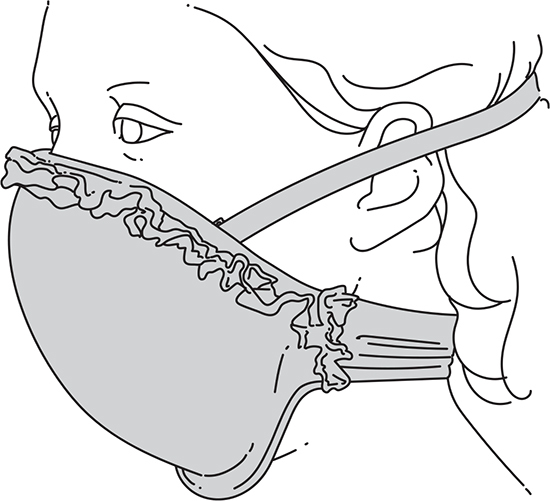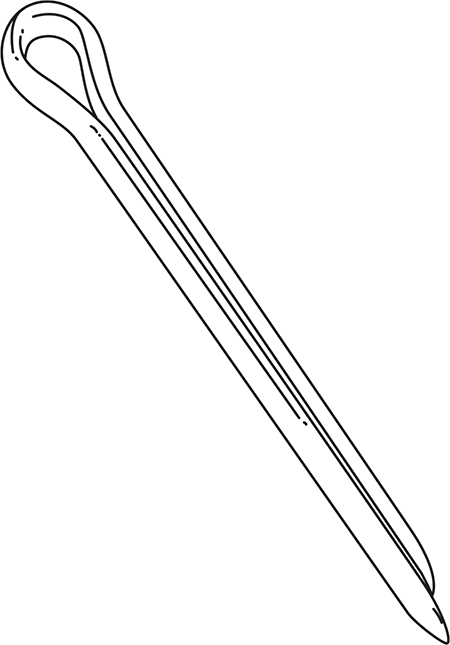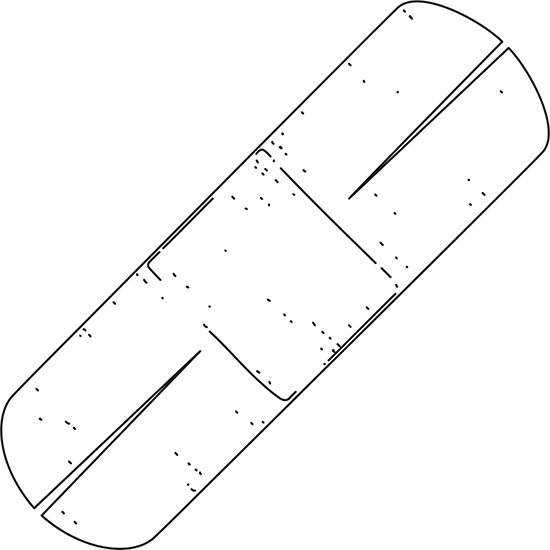HEEL DRIVING—A WALKING HACK
Although this tip doesn’t use an everyday object, it’s what I will call a walking hack. Over the years I’ve seen too many people fall while descending a steep grade, some injuring themselves. There is an effective method of walking down very steep hills that many do not know. I learned this as a small child from a man in the logging industry who spent most of his life wrangling trees on Kentucky’s steep ridges.
Most people walk sideways down a steep grade, which feels safer but is actually very dangerous. It’s almost always more difficult to recover from a sideways fall, and knee, hip, and ankle joints prefer not to bend sideways. The proper way is to drive the heel in the ground while stepping down the hill face forward. The heel creates a small stairstep and prevents the foot from slipping on forest duff at a steep angle. This works very well with and without snow.
2-JACKET STRETCHER
Hauling an unconscious or injured survivor out of the woods is no easy task. In certain cases (especially with a broken neck or back) using a stretcher is the safest and more effective method. In the absence of a strong tarp that can be used for the body of the stretcher, 2 jackets will work just fine. First build a rectangular framework using 4 saplings and tying a square lashing at the corners. Next, slide the jackets over the length of the framework, end to end, with the zippers or buttons closed. Once the jackets are in place, tie the arms together on the back side to pull the front of the jackets taut across the frame. This arrangement should be strong enough to carry even an adult male to safety.

HACK YOUR TEMPERATURE WITH A WET BANDANA
The body is a radiator, and blood is the coolant. During times of extreme heat or overexertion, a wise woodsman can trick the body into cooling down by wetting and exposing the areas where blood runs close to the skin, called pulse points. A cool, wet bandana applied to the temples (temporal), neck (carotid), front side of the elbow (brachial), wrists (radial), inner thigh (femoral), back of the knee (popliteal), and inner ankle (posterior tibial) can cool the blood running close to the surface in those areas and therefore help to cool the entire body. In cool climates, insulating the pulse points can have a warming effect. Your fingers are often cold not because of poor circulation but because your wrist is exposed and the blood is not providing necessary warmth to the fingers.
BRA CUP DEBRIS MASK
Toxic ash and debris can be a serious problem during natural or manmade disasters. Breathing in ash, pulverized concrete, and debris particles can slow you down as well as result in severe long-term conditions such as asthma and lung cancer. Most women carry 2 hack debris masks on their person at all times—a bra! The padded cups of most bras fit perfectly over the mouth and nose and can act as a crude debris filter in an emergency. The combination of foam, padding, and 2 layers of fabric is much better than most store-bought masks. You can rework bra straps and ties to hold the mask securely on your face for hands-free travel.

CHARCOAL TUMMY AID
Activated charcoal is an effective treatment in the emergency room for poison victims. Activated charcoal tablets can be purchased at almost any pharmacy and are known to absorb toxins, poisons, chemicals, and the like in your system. Charcoal has the unique ability to “attach” to these elements and carry them through your system. The chemical makeup of charcoal is such that it has an incredible amount of attachment points. This is why charcoal is an ingredient in almost every water filter on the market. If you’re in a survival scenario and have a severe stomachache, chances are you won’t have fancy activated charcoal tablets. However, a next best solution is to crush hardwood charcoal (the black stuff, not white ash) from the fire and make a drink. Mix about 2 teaspoons of crushed charcoal with 1 cup of water for a natural stomach pain reliever.
COTTER PIN TWEEZERS
This is another hack from the days of my grandfather. Cotter pins are split pins found on all types of machinery, designed to be used as fasteners. The end of a cotter pin can be filed to a razor-sharp point either with a metal file or an abrasive rock. Because a cotter pin is split into 2 halves, it can be used as a very effective pair of tweezers. By spreading the tines and inserting a dowel, the sharp working ends can be bent inward and used exactly like a traditional pair of tweezers. Cotter pins can be found in every hardware store as well as on farm equipment and lawnmowers. They are often used to hold the tires in place on garden wagons and wheelbarrows.

ORBIT GOGGLES
Several years ago, Orbit chewing gum introduced a cup-style package that fits perfectly in most vehicle cup holders. As I was about to throw one away the other day I noticed how the clear lid resembled a pair of welding goggles. After sourcing another lid and experimenting with some cord I was able to fashion a very suitable pair of protective goggles. The little flap door for popping out a piece of gum serves double duty as a vent to prevent fogging in cold weather. I’ll admit that they resemble the wardrobe from Mad Max, but I have no doubt they’ll protect the eyes from flying debris, branch slaps, dust, and sand. After an injury to my eye several years ago while camping I will never underestimate the importance of eye protection again.

MAKESHIFT BUTTERFLY BANDAGE
Here’s a quick and easy first-aid hack you may never have seen. I learned this one from an Army field medic while taking a wilderness first-aid class a few years back and thought it was great. As you know, bandages are a luxury in a survival scenario and you want to make the best possible use of them when necessary. Often, especially on the hands, fingers, and knuckles, traditional bandages just don’t work that well. To make them more flexible and adaptable, cut a center slice through each of the adhesive strips long-ways from the ends up to the bandage portion. Now, with 4 adhesive strips instead of 2, you can apply the bandage effectively to stubborn body parts.

A BETTER-THAN-NOTHING SOUP CAN GAS MASK
Many do-it-yourself gas masks have 2 main ingredients that help to filter out harmful chemicals/gases: activated charcoal and soda lime. The activated charcoal helps to trap particles as they pass through the breathing element, and the soda lime helps to neutralize acid gases. Equip yourself with a better-than-nothing gas mask in a pinch by packing an empty soup can with half crushed charcoal from a fire and half baking soda (sodium bicarbonate). Neither will perform as well as activated charcoal and soda lime, but both are better than nothing. Take one end completely off of the soup can. Cut a hole and insert a plastic pipe 1" into the other end. Duct-tape it in place so there are no leaks. Pack some paper towels or a rag firmly in the soup can against the pipe opening. Loosely pack the rest of the can with half crushed charcoal and half baking soda and tape another rag on the top to hold it all in place. Breathe in through the pipe and exhale through your nose.